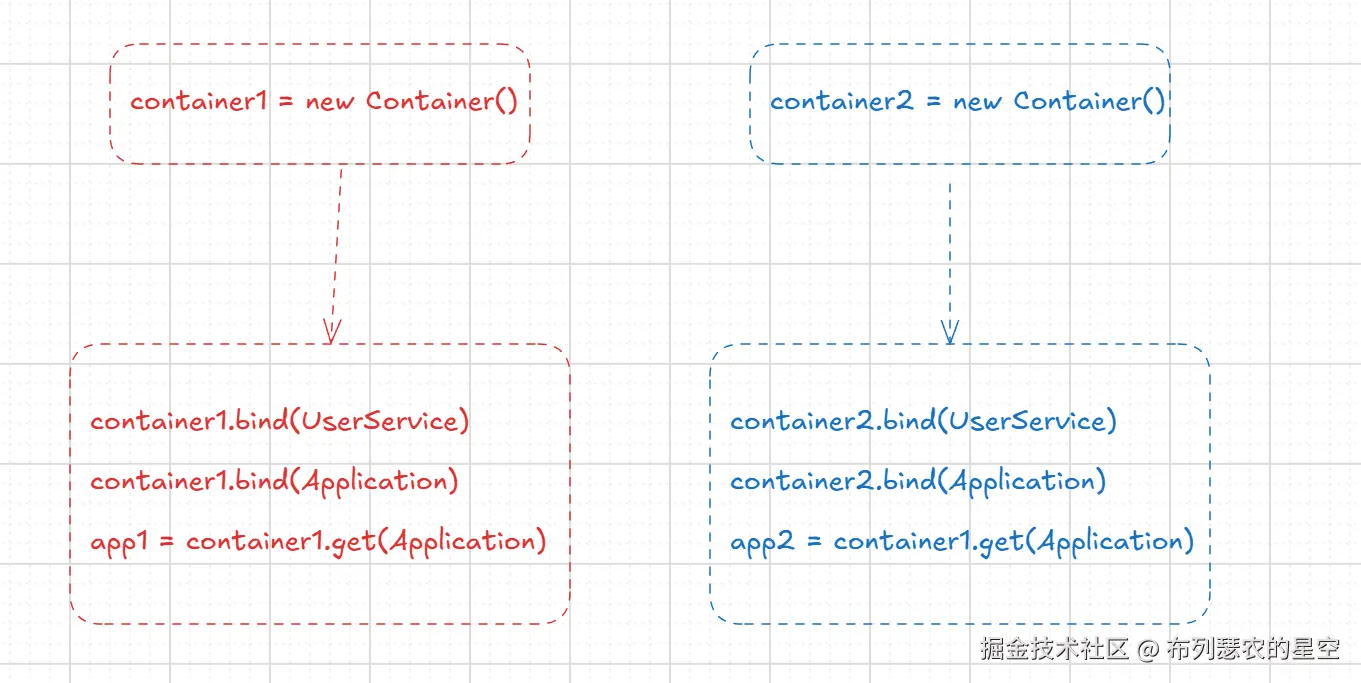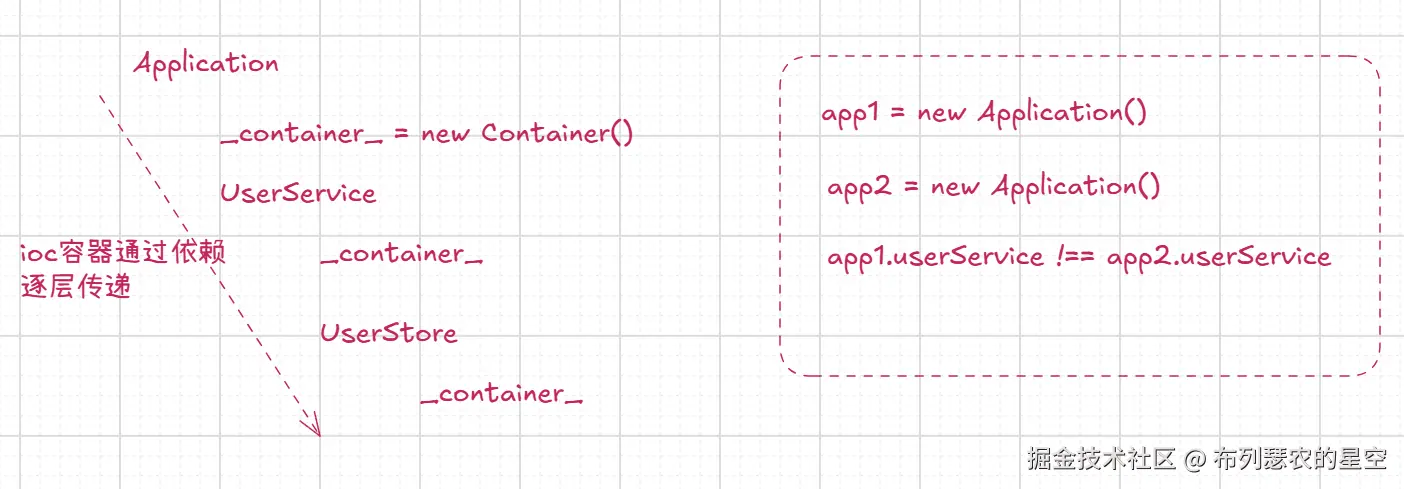前言
本文主要介绍IOC(控制反转)容器与DI(依赖注入)的Typescript实现,如何解决多应用实例下的隔离问题。
如果一个应用极度复杂(多模块/多实例/多事件/多交互/多流程),那么使用DDD设计模式+事件驱动,可能是最优解,而该设计底层必须要实现IOC容器。而web端业务常常会出现多应用实例场景,比如页面上有两个Tab页签或弹窗,其内部分别是两个独立的完整应用。这就必须要求实现IOC容器的隔离。
IOC容器隔离的两种实现思路
容器隔离的核心问题是,如何在构造实例时,将该实例放入对应的IOC容器。对应的思路有两种:
- 先在全局创建不同容器,再通过该容器注册应用内的类

- 创建不同应用时,对该应用创建不同容器,逐层构造注入的依赖实例的同时,也对该实例注入容器。

方案1的实现可以参考社区优秀开源方案:inversify。不过方案2更符合直觉,本文也主要介绍方案2的实现。
单例/多例与IOC容器隔离
IOC容器隔离,也就是两个应用之间各自创建自己的实例对象,这些对象共处同一IOC容器中,但仍然要保持全局对象的单例性。同时应用内也需要支持某些class是多例的。
比如下面例子中,DB对象全局唯一,而Store对象在应用内多例,EventBus与TaskService/UserService应用内单例,
typescript
@Scoped(Scope.Global)
@Injectable()
class DB {
constructor() {
console.log("db");
}
}
@Scoped(Scope.Transient)
@Injectable()
class Store {
constructor() {
console.log("store");
}
}
@Scoped(Scope.Singleton)
@Injectable()
class EventBus {
constructor() {
console.log("event bus");
}
emit() {
console.log("emit");
}
}
@Injectable()
class TaskService {
@Inject() store!: Store;
@Inject() eventBus!: EventBus;
constructor() {
console.log("task service");
}
save() {
console.log("save Task");
}
}
@Injectable()
class UserService {
@Inject() store!: Store;
@Inject() eventBus!: EventBus;
constructor() {
console.log("user service");
}
save() {
console.log("save user ");
}
}最终要实现的依赖注入方式和预期效果如下:
typescript
@App()
class Application {
@Inject() userService!: UserService;
@Inject() taskService!: TaskService;
@Context() context!: IoCContainer;
@Inject() db!: DB;
constructor() {}
}
const app1 = new Application();
const app2 = new Application();
console.log(
app1.db === app2.db, //true,全局单例
app1.context instanceof IoCContainer, //true 注入context
app1 === app2, //false 应用间实例隔离
app1.context === app2.context, //false 应用上下文隔离
app1.userService === app2.userService, // false应用隔离
app1.taskService === app2.taskService, // false应用隔离
Reflect.get(app1.taskService, CONTEXT_KEY) &&
Reflect.get(app1.taskService, CONTEXT_KEY) ===
Reflect.get(app1.userService, CONTEXT_KEY), //true 同应用上下文
app1.userService.eventBus === app2.userService.eventBus, //false 应用单例
app1.userService.eventBus === app1.taskService.eventBus, //true 应用单例
app1.userService.store === app1.taskService.store //false 多例
);App注解实现
App注解最重要的任务是,创建IOC容器并挂到实例上。
typescript
const CONTEXT_KEY = Symbol("CONTEXT");
export function App() {
return function <T extends { new (...args: any[]): {} }>(constructor: T) {
// 创建一个继承自原类的新类
return class extends constructor {
constructor(...args: any[]) {
super(...args);
const context = new IoCContainer();
(this as any)[CONTEXT_KEY] = context;
Reflect.defineProperty(this, CONTEXT_KEY, {
value: context,
writable: false,
enumerable: false,
});
}
};
};
}该属性默认隐藏,不过可以使用@Context注解显示声明需要使用该属性
typescript
function Context(): PropertyDecorator {
return (target: any, propertyKey: string | symbol) => {
Object.defineProperty(target, propertyKey, {
get() {
return this[CONTEXT_KEY];
},
enumerable: true,
configurable: false,
});
};
}IOCContainer实现
createInstance方法会解析inject注解,创建对应实例。
该实现关键点在89行,创建实例的时候将容器自身注入到该实例内,以实现容器的逐层传递。
typescript
export class IoCContainer {
static classRegistry = new Map<string, Constructor>();
static registClass(key: string, value: Constructor) {
this.classRegistry.set(key, value);
}
static instances = new Map<string, any>();
static resolve<T extends Object>(
ctor: Constructor<T>,
...args: ConstructorParameters<Constructor<T>>
): T {
//此处省略
}
static createInstance<T extends Object>(
ctor: Constructor<T>,
...args: ConstructorParameters<Constructor<T>>
): T {
const scope: Scope = Reflect.getMetadata(SCOPE_METADATA_KEY, ctor);
if (scope !== Scope.Global) {
console.warn("IOC 全局对象声明异常");
}
//参考实例上的createInstance,此处实现省略
}
private instances = new Map<string, any>(); // 每个容器有自己的实例存储
resolve<T extends Object>(
ctor: Constructor<T>,
...args: ConstructorParameters<Constructor<T>>
): T {
const scope: Scope =
Reflect.getMetadata(SCOPE_METADATA_KEY, ctor) || Scope.Singleton;
switch (scope) {
case Scope.Global: {
if (!IoCContainer.instances.has(ctor.name)) {
IoCContainer.instances.set(
ctor.name,
IoCContainer.createInstance(ctor, ...args)
);
}
return IoCContainer.instances.get(ctor.name);
}
case Scope.Singleton: {
if (!this.instances.has(ctor.name)) {
this.instances.set(ctor.name, this.createInstance(ctor, ...args));
}
return this.instances.get(ctor.name);
}
case Scope.Transient:
default: {
return this.createInstance(ctor, ...args);
}
}
}
private createInstance<T extends Object>(
ctor: Constructor<T>,
...args: ConstructorParameters<Constructor<T>>
): T {
const instance = new ctor(...args);
const propMetadata =
Reflect.getMetadata(INJECT_METADATA_KEY, ctor.prototype) || [];
for (const { propertyKey, token } of propMetadata) {
//处理inject注解,此处需要先校验该依赖是否标记了injectable,这里省略
const dependency = this.resolve(token);
Reflect.defineProperty(instance, propertyKey, {
value: dependency,
writable: false,
});
}
//这里注入ioc容器
Reflect.defineProperty(instance, CONTEXT_KEY, {
value: this,
writable: false,
});
return instance;
}
}Injectable和Inject实现
Injectable仅作标记,Inject在所属实例运行时,会通过getter按需引用或创建依赖对象。由于类装饰器顺序在属性装饰器之前,此处无法在创建实例的同时,创建依赖实例,只能通过getter按需创建。
typescript
// @Injectable 装饰器(可选,与 @Scope 结合使用)
function Injectable() {
return function <T>(target: Constructor<T>) {
Reflect.defineMetadata(INJECTABLE_METADATA_KEY, true, target);
IoCContainer.registClass(target.name, target);
};
}
// Inject 装饰器:通过属性的类型自动注入实例
function Inject(): PropertyDecorator {
return (target: any, propertyKey: string | symbol) => {
// 获取属性的类型 (通过 reflect-metadata 提供的元数据)
const type = Reflect.getMetadata("design:type", target, propertyKey);
if (!type) {
throw new Error(`IOC 无法解析 ${String(propertyKey)}`);
}
const getter = function (this: { [CONTEXT_KEY]: IoCContainer }) {
if (!this[CONTEXT_KEY]) {
console.error("未注入app context", this);
}
return (this[CONTEXT_KEY] || IoCContainer)?.resolve(type);
}; // 使用类名作为标识符
Reflect.defineProperty(target, propertyKey, {
get: getter,
enumerable: true,
configurable: true,
});
};
}